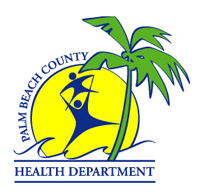Palm Beach County Health Department Director Dr. Alina Alonso explained her organization’s span of services during a meeting hosted Wednesday by County Commissioner Jess Santamaria at the original Wellington Mall.
The Florida Department of Health celebrated its 125th anniversary on Feb. 20. Florida recognized the need for a board of health to control a yellow fever epidemic at the time (1889), and identify and prevent other diseases that affect the health of Floridians.
For 65 years, ever since its department was established, Palm Beach County has been a leader in public health initiatives, said Santamaria, who presented Alonso a plaque in recognition of the department’s achievements.
Alonso has been with the health department for 25 years. She noted that her department is a county organization, although it is financed by the state.
“We’re state employees, but we have a relationship with the county,” she said. “The way it works in Florida is we have a centralized system. We’re employees for the State of Florida at the Tallahassee level, but we work very closely with the Board of County Commissioners, so we kind of have two bosses, the county commission and our boss up in Tallahassee, Florida Surgeon General Dr. John Armstrong.”
However, Alonso’s goal is to respond to the residents of Palm Beach County.
“I feel, like Commissioner Santamaria, that we are public servants in public health,” she said. “As a physician, I don’t make the kind of money I would in private practice, but it’s almost a calling to work for my community.”
All 67 counties in the state work in an integrated health system, which is helpful if there are outbreaks of disease, because the data can be coordinated.
“You may have heard of the outbreaks that we had of contaminated compounding from one of the pharmacies,” Alonso said. “We had infections due to fungal products getting into some mediations. Because of the centralized system, we were able to get that information and work together.”
Some states have health departments that are compartmentalized within counties, which does not promote data sharing and is, therefore, limited in its ability to control or predict the spread of epidemics, she said.
Several years ago, the county had cases of botulism that it was able to trace to a clinic in Boca Raton, Alonso recalled. Two patients were admitted to a hospital in Palm Beach Gardens with botulism, and at the same time there were two other patients admitted in New Jersey.
She explained that the Palm Beach County Health Department submits findings to Tallahassee, which in turn submits reports to the federal Centers for Disease Control & Prevention. New Jersey also submitted its information to the CDC, which was able to link the four cases to a practitioner in Boca Raton giving the wrong concentration of Botox injections.
“It’s that kind of response that you want to have inter-links between your county and your state,” Alonso said.
The mission of the health department is to protect, promote and improve the health of all people in Florida through an integrated state, county and community effort. “We don’t work in isolation,” she said. “We work in partnership with many people.”
The vision is to make Florida the healthiest state in the nation, although right now, its ranking is 48th.
“When you’re that low on the totem pole, you can’t help but strive to be better,” Alonso said. “But in Palm Beach County, I’m happy to say we do a very good job. Part of that is that we have invested in health. We have been partners with our county commissioners. You go to other counties, and that is not the case.”
She pointed out that Palm Beach County has a line item approved by voters to finance the Palm Beach County Health Care District.
Alonso noted that Palm Beach County is not only the largest county east of the Mississippi River, but its 1.3 million population is very diverse. “We’re also known as the wealthiest county, with a per capita income of $44,000,” she said. “We have a lot of resources in Palm Beach County, but we also have a lot of poverty.”
She pointed out that the typical homeless person is a single mother with children, rather than the more visible people seen panhandling. “That is the face of over 75 percent of the homeless people in Palm Beach County — single women with children,” Alonso said.
Typical health issues that the county deals with have to do with an aging population, which is higher in Palm Beach County than the state average.
The Palm Beach County Health Department, which was recently renamed the Florida Department of Health at Palm Beach County, was founded in 1948 by Dr. Clarence Brumback, who died recently although he was still actively treating patients. “He was a people’s doctor,” Alonso said. “He went out in a Rambler and toured the whole county with a nurse. He was someone who really cared deeply about public health.”
Brumback established the county’s model for healthcare by bringing together county and state resources. Although he was employed by the state, Brumback went to the county, which is legally responsible for healthcare for the poor, and proposed that the county build the clinics, and the state would staff them.
Alonso said Palm Beach County does better on the average than comparable counties in vital statistics, with a lower number of neonatal deaths than in Miami-Dade, Broward and Duval counties. The mortality rate and AIDS cases per 100,000 are also lower.








